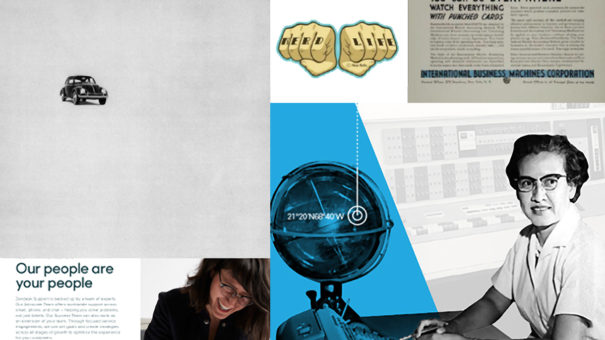
Enterprise Tech Personas Are Human Too
But what we’re really talking about is getting brands to move away from a tone of voice-to being a multidimensional personality.” Brian Millar, Founder and CEO of the Emotional Intelligence Agency, Contently: The Four Kinds of Content that Work Best
“That looks or sounds very consumer or small business.” — a dreaded phrase to Creative ears. This fearful voice often rings in alarm when copy is conceptual or attempting to relate to the reader in a more personal way. Art Direction suffers similar aspersions when work is too “designy” and metaphorical. An overly cautious approach is not new to the enterprise tech market. Agency folk have a long history of dancing with clients back and forth on the virtues of how to connect with people in meaningful ways. Often the client wants to be clear about what they offer, state direct benefits, and ultimately find meaning in direct sales results. The Creatives wish to establish relationships, spark the imagination, and create brands that yield results through goodwill and sincerity, coupled with fine products. It’s described in many circles as authenticity now and falls in the domain of Content Strategy. Buyers’ journeys are backed with enough data to allow for longer buying cycles, but the differences in approach remain constant.
Don’t Overthink
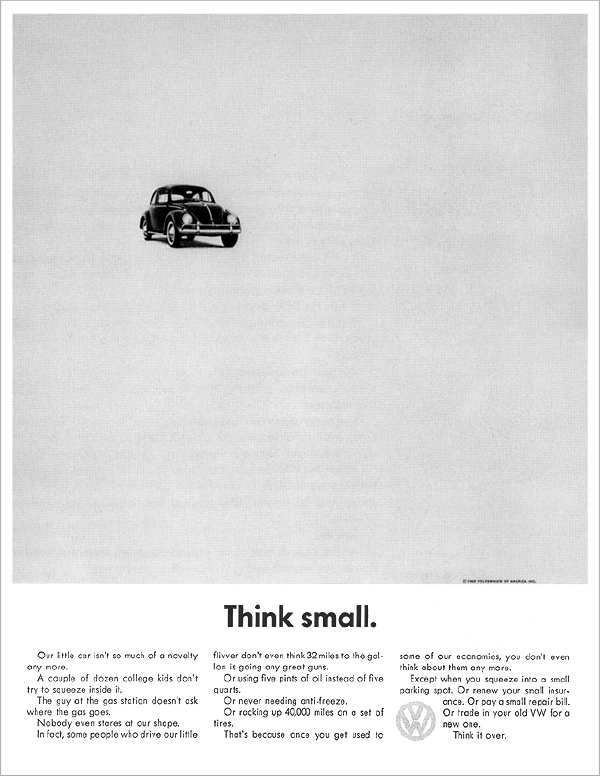
Image: Volkswagen, “Think small.” 1959
We can trace this flamenco dance back to the Bernbach Volkswagen “Think Small” ad in 1959, which introduced the world to the technique of being modest, unexpected, and refreshingly candid. Read the body copy and you’ll see they still got in all kinds of positive details about performance and value. Yes, it is a consumer product, but it started a trend that went wildly viral.
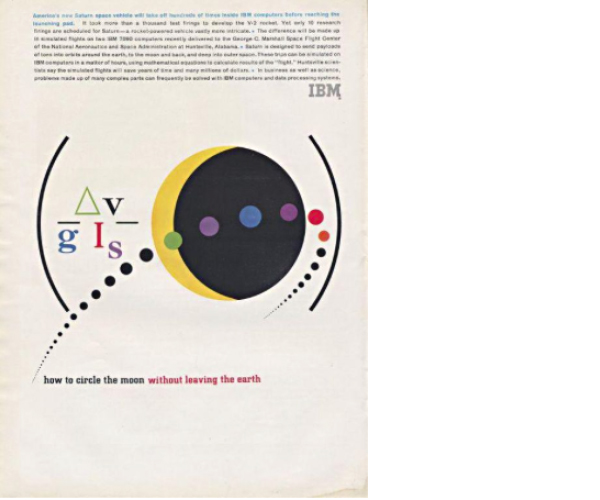
Image: IBM ad by Benton and Bowles, 1961
Benton and Bowles made the above ad for IBM in 1961, for the IBM 7090, which had a price tag of $2.9 million dollars. That’s $55,400,000 in 2016, so well within the enterprise category. The ad is beautiful to look at (please pardon the blog-length body copy, those were more patient times), intrigues the beholder, inspires space-age wonder, and informs the reader on the virtues of the product. It shows, doesn’t tell, which is the beauty of good storytelling, and why Apple ads are so iconic.
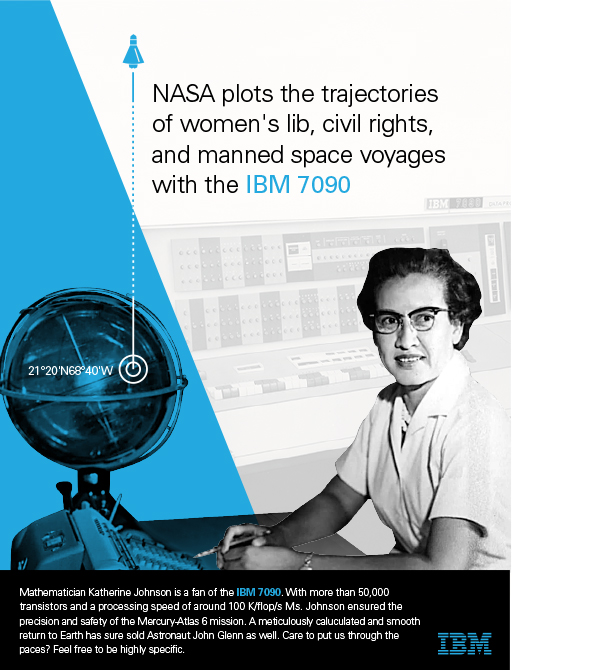
Image: Concept ad created by Harry Topalian
In tribute to the remarkable women who worked at Nasa and used the IBM 7090 for the Mercury-Atlas 6 mission in 1962, we created an ad that would have pushed the IBM brand into some bold, new territory. Would the world have been ready for it? If not, that doesn’t mean it would not have been of benefit for a brand that dared to run it.
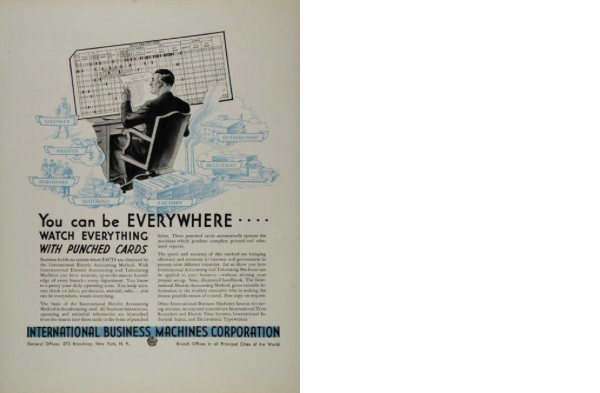
Image: IBM ad, 1934
It’s sad to see so few examples of creativity coming out of technology companies now. The above IBM ad from 1934 seems an awful lot like today’s tech websites—a literal depiction of what the product does and what you can do with it. Swap out the punch card with an all-powerful cloud symbol, and it’s a pure SaaS play.
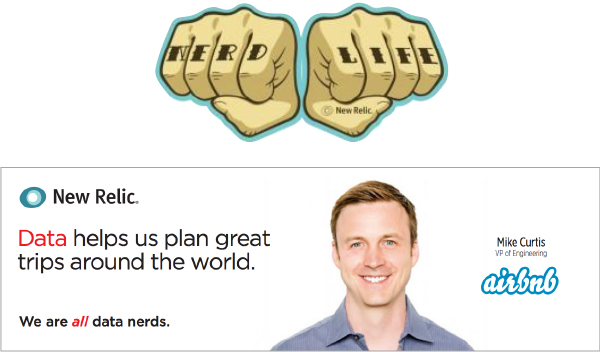
Image: New Relic sticker and banner, 2014
Let’s not dwell on the mundane. New Relic’s “We are all data nerds” campaign that launched in 2014 is a charming hybrid—quirky candor and literal product explanation and benefits all in one. Identifying the power found in owning otherness and rejoicing in dorky camaraderie is refreshingly real. And they still manage to sell a complicated product that could get a CIO fired if it failed her.
The subsequent campaign was short-lived, likely polarizing, and despite its message, quite refreshing.
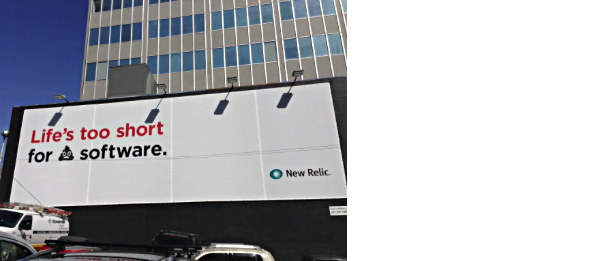
Image: New Relic billboard, 2015
If you’re trying to persuade people to do something, or buy something, it seems to me you should use their language.” David Ogilvy
The big question the above quote begs is “what is the language of your audience?” Just because someone’s job places them in a persona-niche of a left-brained thinker with crushing responsibilities, does that mean they appreciate being talked to as though they are AI? Of course not, but the old chestnut about “selling the sizzle, not the steak” also addresses the counterargument that no-nonsense folks don’t want to accosted with marking spin.
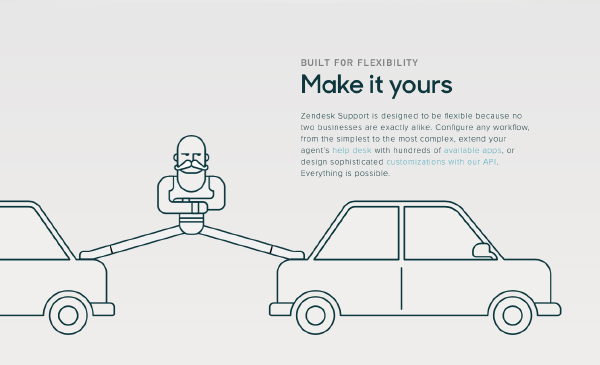
Image: Zendesk, support page, 2017
Zendesk’s evocative brand personality isn’t a new development and is commendable. A visit to their current website is a treat. The colorful and playful design has a Scandinavian-inspired flourish, charming graphics, and the copy feels good—personable, concerned, and just clever enough to imply the familiarity of a long-lasting relationship.
The subheads and body copy work particularly well on their product page. They sum up their offering at the bottom of the page with “Our people are your people,” which captures their brand promise and voice strongly enough to be a sweet tagline. Kirk Cheyfitz, Co-CEO & Chief Storyteller from Story Worldwide, summed up this altruistic sentiment when he said “Like a halfway decent human being, brands have to be about more than themselves.”
Tapping into some post-Great Depression wisdom, we can reflect on Dale Carnegie’s classic How to Win Friends and Influence People. It’s a mainstay in sales and advertising and of the “Six Ways to Make People Like You,” the step of “Make the other person feel important—and do it sincerely” is one of the tenants that is often missing in the marketing of analytical products.
Urgency rarely leads to trust.” Seth Godin, Evoking online trust
Christopher Booker’s The Seven Basic Plots explores the archetypes of the human story as: 1. Overcoming the Monster, 2. Rags to Riches, 3. The Quest, 4. Voyage and Return, 5. Comedy, 6. Tragedy, 7. Rebirth. The much-touted authenticity element is missing in a lot of work because brands try to avoid delving into exploring Booker’s archetypes. They focus instead on only the applied values of using their specific products and features—for a success that doesn’t tie back to the plot-points that drive the human soul. How does the value of working more efficiently relate to The Quest? Is a brand inspirational in how it ties its value to the Rags to Riches archetype, or does it just flatly tell you you’ll get rich? When the person(a) Overcomes the Monster of old technologies with the brand’s product, what does it really do for the user? Self-serving agendas can be whiffed a mile-away—the pushy calls to action, the generic positioning —and ultimately telling facts, rather than showing ideas, illustrating values, and unifying emotions with intellect for a complete human experience.
BEAR WITH A LITTLE FRIGHTFUL PSYCHOBABBLE
Fear is often at the heart of why companies choose to present themselves in mediocre, generic ways. Fear is reasonable. Fear of failure is justifiable. The cost of living within a three-hour drive of metropolitan areas is crushing. Committee-think is an unrelenting form of peer pressure and success is measured harshly.
According to Theo Tsaousides, Ph.D., “We get scared of what we imagine could happen.”1 That fearful second-guessing kills many strong ideas. Rather than being concerned with “What if someone doesn’t get it?” it would be more positive if more people feared ‘What if no one really relates to our brand?” Unfortunately, what ends up happening is the fear becomes intensified as pressures rise, and it turns to fright, which Tsaousides claims, “You neither fight nor flee; in fact, you do nothing—well, you obsess about the layoffs, ruminate, complain, but you take no action.”2 This “no action’” often comes in the form of banal work that reaches many but touches few.
Overcoming fear in others, particularly others who have higher positions and bigger responsibilities is not to be underestimated. People’s fear is a dangerous undertaking, so the first step is to face it oneself. If you’re bold, share your concern about giving in to your own fears. Admit how you see it as a failure if you let it compromise the integrity of the living embodiment of the brand you’re creating and presenting to the world. Maybe others will be inspired to do the same.
BIG IDEAS, PRECISE STRATEGY
Changing people’s minds, combating subjectivity, overcoming fears and impacting group-think is a formidable undertaking. An effective tactical approach is to employ the A/B test. Introducing creative, emotive and conceptual work has a better chance of making it live by starting out small. Choose a group in an organization that is the most open-minded and is already comfortable with the A/B approach. Offering to do a test of banner ads is a much lower risk than modifying a homepage or running a billboard. If the results are in favor of your work it will likely be way more persuasive than espousing quotes from Ogilvy. Data makes its way into presentations that reach analytical decision makers.
This may be easier to do if you’re working in-house. Having worked in agencies and internally it’s fascinating to compare and contrast the pros and cons. One big pro of being part of an in-house creative team is you get exposed to the internal workings, culture and politics of a company. You also get to build deeper relationships with varying teams. You’re there day in and out, eating lunch together, and going to meetings and parties—you’re one of them. It can seem less risky to trust you because you’re perceived as being as invested in the good of the company as your fellow employees.
As a Creative in an agency you don’t get to just drop by clients desks to run ideas by a stakeholder. You can work with an Account Executive to share results from past test successes. Showing you’re thinking about the good of a client’s business above and beyond immediate asks is memorable. Taking the time to show you’re concerned about minimizing risk and not just being creative for the sake of your own gratification goes a long towards building trust.
Trust drives decision-making and it’s in short supply. Concern over the global technology obsession and loss of intimacy in our society is only increasing. Chip implants are a distinct possibility, so standing our ground as people is more important than ever. We can’t expect the computer intelligences that are getting brainier and more independent by the nanosecond to defend our souls, especially not on their turf. Reminding people that it’s us vs. our inventions could be a fine last resort in the struggle for creating brands that contribute to humanity.
1. Tsausides, Theo, Ph.D., Psychology Today, “7 Things You Need to Know about Fear,” November 19, 2015.
2. Ibid.
